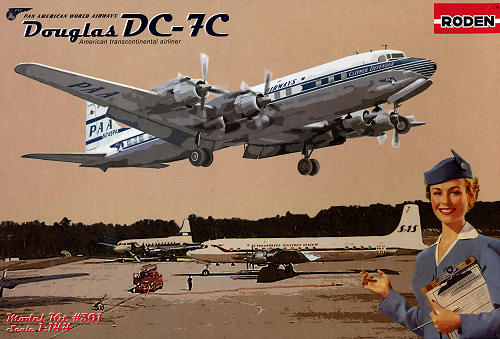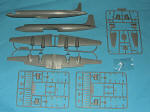
Roden 1/144 DC-7C
| KIT #: | 301 |
| PRICE: | $32.99 SRP |
| DECALS: | One option |
| REVIEWER: | Scott Van Aken |
| NOTES: | New mold kit |

| HISTORY |
Pan American World Airways originally requested the DC-7 in 1945 as a civilian version of the Douglas C-74 Globemaster military transport. It canceled its order shortly afterward.
American Airlines revived the designation when it requested an aircraft that could fly the USA coast to coast non-stop in about eight hours. Robert Rummel (at the time head of engineering at TWA) has stated that pilot union rules limiting flying time to eight hours per day influenced American's request to Douglas. However, Douglas was reluctant to build the aircraft until American Airlines president C. R. Smith placed a firm order for 25 at a price of $40 million, thus covering Douglas' development costs.
The prototype flew in May 1953 and American received its first DC-7 in November, inaugurating the first non-stop east-coast-to-west-coast service in the country (optimistically scheduled just under the eight-hour limit for one crew) and forcing rival TWA to offer a similar service with its Super Constellations. Both aircraft, however, frequently experienced in-flight engine failures, causing many flights to be diverted.
The original DC-7 was followed by another variant, the DC-7B, which was identical except for slightly greater power and, on some DC-7Bs, increased fuel capacity in extended engine nacelles. South African Airways used this variant on their Johannesburg to London route.
The early DC-7s were only sold to U.S. carriers. European carriers could not take advantage of the small range increase in the early DC-7, so Douglas released an extended-range variant, the DC-7C (Seven Seas) in 1956. A 10 feet (3.0 m) wing-root insert added fuel capacity, reduced interference drag, and made the cabin quieter by moving the engines further outboard; all DC-7C's had the nacelle fuel tanks previously seen on Pan American's and South African's DC-7Bs. The fuselage, which had been extended over the DC-6B's by a 40 inches (100 cm) plug behind the wing for the DC-7 and -7B, was lengthened by a similar plug ahead of the wing to give the DC-7C a total length of 112 feet 3 inches (34.21 m).
| THE KIT |
 Aside from the very old Revell box scale DC-7C
and the F-RSIN kit, this is the
only other Injected Plastic kit of this variant of which your reviewer is aware. Due, I'm sure, to the need to make a
longer fuselage and a longer wing, other companies have not attempted this
variant.
Aside from the very old Revell box scale DC-7C
and the F-RSIN kit, this is the
only other Injected Plastic kit of this variant of which your reviewer is aware. Due, I'm sure, to the need to make a
longer fuselage and a longer wing, other companies have not attempted this
variant.
Roden's kit is not a very complex one though in some areas, complexity has been added, and by that I mean the two piece prop spinners and the separate blades. I really hate these things on models of this scale, but Roden has done so in order to allow both clipped and rounded tip blades to be used. If there is an upside, at least doing one 'in flight' by replacing the blades with a clear disc will be much easier.
Anyway, the kit has engraved panel lines and to allow for the variety of different window and door treatments, the fuselage is a blank slate. The cockpit windows are included with a fuselage section to make blending a bit easier. There is a cockpit floor (which also provides the nose gear attachment point) and rear bulkhead, but nothing else for the front office. Lots of room for nose weight so that won't be an issue. Engine nacelles are in left and right sides with one trapping the somewhat minimally detailed engine face in between. I was hoping for well detailed engine intakes, but they are the usual flat faces that one can paint or carefully grind out.
Landing gear is well molded, though on the disc nose wheel there are some large sink areas, making it unusable. There is an optional 'finned' nose wheel that may not be appropriate to the Pan Am DC-7C but does not have the large sink areas. All of the gear wells are open with attachment points provided for the main struts. Main gear and doors are suitably complex. It appears that no gear up option is provided. I'm not sure how well the doors will fit in the closed position. The lower wing has the cooling scoop molded on and you are given a small opening piece to apply.
The molding of the kit is fairly well done. I found flash on a number of parts, but it isn't a lot and easy to remove. The engraved detailing is fairly good. I like that the control surfaces are all molded on one part half. This provides and nice trailing edge. A few tiny surface molding glitches were noticed, but nothing that sand paper and/or filler cannot fix. When I opened the box and looked at the parts, I was reminded quite a bit of a Minicraft kit in terms of general detailing and parts quality. It also looks to build very much like their DC-6B, but perhaps there are just only so many ways to build an airliner.
 Instructions are well done with nicely drawn construction
steps that include color information though you will need to visit the full
color marking and painting guide to find out what the references mean. The decal
sheet is very well printed; nice and crisp and colorful. The instructions
provide guidance as to cutting the nose part of the side decals. It is quite
specific so one would be cautioned to follow it as exactly as one can. The PAA
markings are the only livery supplied, but I'm sure that aftermarket will not be
far behind.
Instructions are well done with nicely drawn construction
steps that include color information though you will need to visit the full
color marking and painting guide to find out what the references mean. The decal
sheet is very well printed; nice and crisp and colorful. The instructions
provide guidance as to cutting the nose part of the side decals. It is quite
specific so one would be cautioned to follow it as exactly as one can. The PAA
markings are the only livery supplied, but I'm sure that aftermarket will not be
far behind.
| CONCLUSIONS |
A kit that I'm sure many propliner fans have been long awaiting. It is now here and can be added to your airliner collection.
| REFERENCES |
http://en.wikipedia.org/wiki/DC-7C
January 2011
Thanks to Squadron Products for the preview kit. Get yours at your local retailer.
If you would like your product reviewed fairly and quickly, please contact me or see other details in the Note to Contributors.